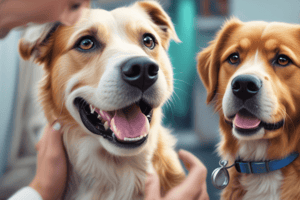Podcast
Questions and Answers
Which method is NOT part of the core skills of history taking?
Which method is NOT part of the core skills of history taking?
- Empathy
- Reflective listening
- Pausing
- Leading with closed questions (correct)
What is the first step in the history taking process?
What is the first step in the history taking process?
- Perform a general overview
- Develop the chief complaint through further questioning
- Start with open-ended questions (correct)
- Identify the chief complaint
In body systems review, which symptom would NOT typically be discussed?
In body systems review, which symptom would NOT typically be discussed?
- Recent diet changes (correct)
- Vomiting
- Diarrhea
- Urinary incontinence
Which of the following is NOT included in dietary history?
Which of the following is NOT included in dietary history?
What aspect of patient history does NOT need to be evaluated at the end of the interview?
What aspect of patient history does NOT need to be evaluated at the end of the interview?
What is considered the most important diagnostic tool for veterinarians?
What is considered the most important diagnostic tool for veterinarians?
Which of the following is an example of objective data in veterinary history taking?
Which of the following is an example of objective data in veterinary history taking?
What aspect of the patient’s environment is NOT relevant during history taking?
What aspect of the patient’s environment is NOT relevant during history taking?
What percentage of the course grade is determined by term exams in VMed 101?
What percentage of the course grade is determined by term exams in VMed 101?
Why is history taking considered crucial in the clinical examination of animals?
Why is history taking considered crucial in the clinical examination of animals?
Which of the following falls under the category of subjective data in veterinary history?
Which of the following falls under the category of subjective data in veterinary history?
What is the primary purpose of obtaining a complete history from pet owners?
What is the primary purpose of obtaining a complete history from pet owners?
What is NOT included in the objective data during veterinary history taking?
What is NOT included in the objective data during veterinary history taking?
Flashcards
VMED 101 Course Description
VMED 101 Course Description
Principles of diagnosis and treatment of animal diseases.
VMED 101 Assessment Components
VMED 101 Assessment Components
Term Exams (40%), Quizzes (35%), and Assignments (25%).
Knowledge Required for Clinical Exam
Knowledge Required for Clinical Exam
Anatomy, physiology, pathology, and animal behavior.
History Taking
History Taking
Signup and view all the flashcards
Objective Data
Objective Data
Signup and view all the flashcards
Signalment Data
Signalment Data
Signup and view all the flashcards
Environmental History
Environmental History
Signup and view all the flashcards
Diet History
Diet History
Signup and view all the flashcards
Preventive Health Care Status
Preventive Health Care Status
Signup and view all the flashcards
Prior Medical History
Prior Medical History
Signup and view all the flashcards
Primary Complaint
Primary Complaint
Signup and view all the flashcards
Core History Taking Skills
Core History Taking Skills
Signup and view all the flashcards
History Taking Steps
History Taking Steps
Signup and view all the flashcards
Study Notes
Course Information
- VMED 101: General Principles of Veterinary Medicine is a 2-unit course offered in the first semester.
- The course covers the principles of diagnosis and treatment of animal diseases.
- It's a 2-hour lecture per week.
- Prerequisites: Veterinary Bacteriology and Mycology (VMIC 102) and Veterinary Systemic Pathology (VPAT 102).
Course Assessment
- The course assessment is based on:
- 40% Term Exams
- 35% Quizzes
- 25% Assignments
The Clinical Examination
- The veterinary clinical examination requires knowledge of:
- Anatomy
- Physiology
- Pathology
- Animal behavior
- It involves:
- Clinical Examination
- Clinical Signs
- Pathogenesis of the Disease
History taking
- History taking is crucial for diagnosing animal diseases.
- It should be obtained from the owners.
- It helps prevent:
- Unnecessary diagnostic testing.
- Needless costs for the owners.
- History taking involves both objective and subjective data.
Objective Data in history taking
- Signalment:
- Species
- Breed
- Age
- Sex
- Reproductive status
- Weight
- Environment:
- Where the pet is kept
- Free-roaming or confined
- Geographic origin
- Recent travel history
- Water source
- Toxin exposure
- Access to houseplants or outdoor vegetation
- Diet:
- Appetite
- Weight gain or loss
- Diet type
- Brand name of food
- Snacks
- Feeding method
- Amount
- Preventive Health Care Status:
- Vaccination history
- Parasiticide history
- Prior Medical History:
- Previous illnesses
- Medications administered
- Other interventions
Subjective Data in history taking
- Primary Complaint:
- Detailed description of the reason for the visit
History-Oriented Body System Review
- Eyes
- Head, Neck, Ears, Nose, and Oral Cavity
- Cardiopulmonary System
- Digestive System
- Urinary System
- Genital System
- Integumentary System
- Musculoskeletal System
- Nervous System
5 Core Skills for History Taking
- Open and close-ended questioning.
- Reflective listening.
- Pausing.
- Positive nonverbal communication.
- Empathy.
History Taking Steps
- Start with open-ended questions and transition to close-ended questions.
- Identify the chief complaint.
- Develop the chief complaint through further questioning:
- Onset, duration, frequency, severity, location.
- Progression or improvement.
- Factors that increase or decrease clinical signs.
- Attempted treatment and outcomes.
- Obtain a body systems review.
- Perform a general overview to identify risk factors:
- Patient's lifestyle.
- Humans associated with the patient.
- Patient's environment.
- Vaccination and parasite preventive history.
- Concurrent or previous illnesses.
- Medications administered.
- Other interventions.
- Ask the owner about any other concerns.
- Conduct a physical examination.
Studying That Suits You
Use AI to generate personalized quizzes and flashcards to suit your learning preferences.




